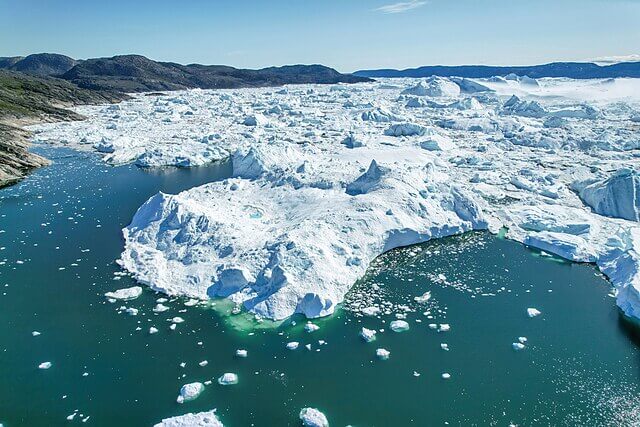
A recent study has uncovered alarming trends in Greenland’s ice loss, revealing that the ice cap is shedding an average of 30 million tonnes of ice per hour due to the intensifying climate crisis, a figure 20% higher than previously estimated.
This accelerated melting poses grave concerns among scientists, as the increased influx of freshwater into the North Atlantic could hasten the collapse of the Atlantic meridional overturning circulation (Amoc), potentially triggering severe repercussions for humanity.
While previous methods, such as measuring ice sheet height or weight using gravity data, have effectively tracked ice loss impacting sea levels, they have struggled to account for glacier retreat occurring primarily beneath sea level in Greenland’s narrow fjords.
In response, the study employed satellite imagery analysis to track changes in glacier end positions from 1985 to 2022, revealing widespread and substantial shortening amounting to a trillion tonnes of lost ice.
“The changes around Greenland are tremendous and they’re happening everywhere – almost every glacier has retreated over the past few decades,” said Dr Chad Greene, at Nasa’s Jet Propulsion Laboratory in the US, who led the research. “It makes sense that if you dump freshwater on to the north Atlantic Ocean, then you certainly get a weakening of the Amoc, though I don’t have an intuition for how much weakening.”
The vulnerability of the Amoc has been a growing concern, with recent studies indicating its weakest state in 1,600 years and potential collapse as early as 2025 in worst-case scenarios.
Furthermore, scientists fear that a significant portion of the Greenland ice sheet is nearing a tipping point of irreversible melting, potentially contributing to 1-2 meters of sea level rise.
Published in the journal Nature, the study utilised artificial intelligence to map over 235,000 glacier end positions over 38 years, unveiling a loss of approximately 5,000 square kilometres of ice at Greenland’s margins, equivalent to a trillion tonnes of ice.
When combined with data from other sources, the total ice loss from Greenland since 2003 amounts to a staggering 221 billion tonnes annually, with the new study adding an additional 43 billion tonnes per year.
The scientists said: “There is some concern that any small source of freshwater may serve as a ‘tipping point’ that could trigger a full-scale collapse of the Amoc, disrupting global weather patterns, ecosystems and global food security. Yet freshwater from the glacier retreat of Greenland is not included in oceanographic models at present.”
The influx of freshwater into the sea, resulting from Greenland’s melting ice, disrupts the ocean’s normal processes, slowing the sinking of dense, salty water in polar regions and affecting the Amoc.
Prof Tim Lenton, at the University of Exeter, UK, and not part of the study, said: “This additional freshwater input to the north Atlantic is a concern, particularly for the formation of deep water in the Labrador and Irminger Seas within the subpolar gyre, as other evidence suggests these are the regions most prone to being tipped into an ‘off’, or collapsed state.”
“That would be like a partial Amoc collapse, but unfolding faster and having profound impacts on the UK, western Europe, parts of North America, and the Sahel region, where the west African monsoon could be severely disrupted,” he said. “Whether this previously unaccounted source is enough freshwater to make a difference depends on how close we are to that subpolar gyre tipping point. Recent models suggest it could be close already at the present level of global warming.”
However, Prof Andrew Shepherd, at the University of Northumbria, UK, said: “Although there was a step-change in glacier retreat at the turn of the century, it’s reassuring to see that the pace of ice loss has been steady since then and is still well below the levels needed to disturb the Amoc.”
Additionally, the study’s findings are crucial for understanding Earth’s energy imbalance caused by human-induced greenhouse gas emissions, highlighting the urgent need for mitigation efforts.
“It takes a lot of energy to melt 1tn tonnes of ice. So if we want very precise energy balanced models for the Earth, this has to be accounted for.”
It’s worth noting that the lost ice from the analysed glaciers, mostly located below sea level, is replaced by seawater and does not directly contribute to sea-level rise.
But Greene said: “It almost certainly has an indirect effect, by allowing glaciers to speed up. These narrow fjords are the bottleneck, so if you start carving away at the edges of the ice, it’s like removing the plug in the drain.”
Meanwhile, a separate study by Greene and colleagues, published in 2022, revealed a significant loss of Antarctic ice shelves since 1997, doubling to approximately 12 trillion tonnes when considering both shrinking areal extent and thinning.
——————————————————————————
At Natural World Fund, we are passionate about stopping the decline in our wildlife.
The decline in our wildlife is shocking and frightening. Without much more support, many of the animals we know and love will continue in their decline towards extinction.
When you help to restore a patch of degraded land through rewilding to forests, meadows, or wetlands, you have a massive impact on the biodiversity at a local level. You give animals a home and food that they otherwise would not have had, and it has a positive snowball effect on the food chain.
We are convinced that this is much better for the UK than growing lots of fast-growing coniferous trees, solely to remove carbon, that don’t actually help our animals to thrive.
This is why we stand for restoring nature in the UK through responsible rewilding. For us, it is the right thing to do. Let’s do what’s right for nature!
Donate today at https://naturalworldfund.com/ and join in the solution!

